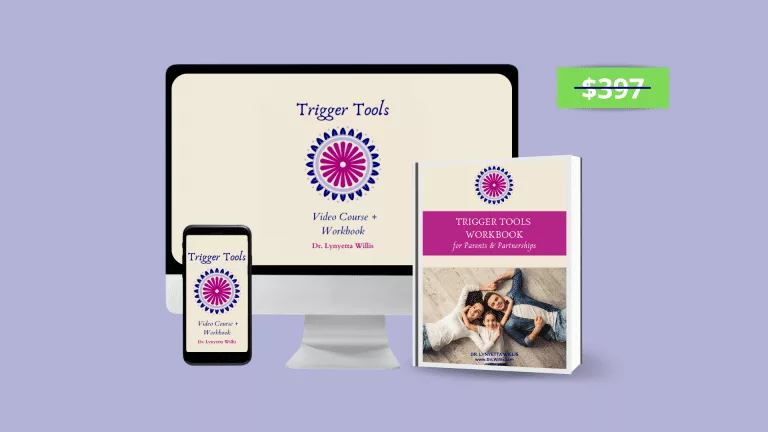3 Things You MUST Know to Transform Your Triggers

Have you heard a part of yourself saying one or more of these?
“My anger, it just goes from zero to 60 when my partner does that thing.”
“I know I’m screwing up my kids I feel so guilty.”
“I don’t understand why I keep yelling, but I know I need to stop.”
Or maybe you’re on the other side of the spectrum.
You hear yourself saying things like, “I just give in when my kid starts to cry” or
“I just shut down when my partner and I are in the middle of that fight.
For the fifteenth time.”
If your response to hearing one or more of these statements was, “how does she know?!”
There’s a good chance you’ve experienced a trigger.
In today’s video, we’re going to get clear on what you need to know about your triggers, to transform your relationship with them.
If we haven’t met yet, hello, I’m Dr. Lynyetta Willis. I’m a psychologist, Family Empowerment Coach, Keynote Speaker and Author.
I help frustrated families break free from Stable Misery® in their parenting and in their partnerships, so they can create more harmony and joy in their homes.
If the statements I shared a moment ago sound familiar, the first thing I want you to know is, you’re not alone.
I was able to share these quotes not because I bribed Siri and Alexa to allow me to listen in on your family conversations, but because these are actual phrases for my parenting clients and my couples clients. They use these exact words and phrases to describe their triggers.
So you see, it’s not just you.
Now, let’s start out by defining a trigger.
It’s those moments when our child or partner says or does things that awaken within us difficult emotions such as fear, powerlessness, or anger.
And when those emotions wake up, we may react in ways that go above and beyond what the situation needs.
A shortcut definition. I like to use is, “you know, you’re triggered when you bring an atom bomb reaction to a laser beam moment.
This happened to me recently with my kid. It was a school day. I thought we had it all together.
Kids got up dressed, fed, bookbags packed, lunches packed.
I felt like, Super Mom awaaay.
We drive to school, we pull up and I say, “bye babies, I love you.”
And in that moment, my son gives me that look. I know that look.
You know that look.
And I asked the question, I really don’t want to know the answer to, “what?”
He looks at me and he says, “I forgot my shoes.”
Of course he did.
I can laugh now, but then I didn’t.
My response went something like:
“how would you forget your shoes? Seriously? You went out to play. Didn’t I say, make sure everything was done before you went out to play? That includes your shoes. Now I have to drive you all the way home, and I have an appointment. Seriously? Oh, I can’t believe this. We got to get better. We can’t keep doing this. We’ve got to talk about this. Family meeting tonight!”
The entire time, he’s just sitting there in the back seat, door half open, naked foot hanging out, swinging in the wind, waiting for the wave that is his mom to finally crash.
In the midst of my verbal tsunami, I looked at his face and it hit me,
I’m triggered.
I was bringing an atom bomb reaction to a laser beam moment.
What did I want instead? If I had it all my way?
Probably the same thing you want when you find yourself in those moments.
The ability to give a laser beam response during a laser beam moment.
The ability to connect with your child more than you correct them.
The ability to notice when your “stuff” is getting in the way of how you want to respond. And the ability to know what to do instead.
That sound about right? But that’s hard when we’re triggered.
Right?
Well, today I’m going to talk about the Trigger Train and three things you need to know about your triggers so you can find that laser beam and respond effectively during those difficult parenting or partnership moments, regardless of what your kid or partner is or is not doing.
How does that sound?
Alright, the Trigger Train.
Our trigger’s are external to us.
What starts the Trigger Train rolling down the tracks is a trigger or someone else’s behavior.
Our kid’s crying or yelling, or our partner’s sarcasm or their habit of walking away in the middle of an argument.
Okay, those things may be are triggers.
This behavior represents the first car of the Trigger Train or a steam engine.
Right?
This is what gets the train rolling down the tracks.
My kids saying, “I left my shoes,” was the steam engine that morning.
The next car contains our stories, the stories in our head, or the thoughts about ourselves, our child, our partner, or the situation.
For me, it was, “crap, if my kid can’t remember his shoes, how is he going to take care of himself when he’s older? I don’t want him living in my basement when he’s 40.”
The third car represents our intense, difficult feedings, that their behavior triggers in us.
For me, it was anger, overwhelm, a bit of fear.
And the fourth car contains our intense reaction – yelling, shaming, blaming.
For me, it was a long, useless, self-righteous lecture.
That he probably wasn’t listening to anyway.
And when all of these cars are hooked together, triggering behavior; our thoughts, stories in our head; our feelings; and our reactions.
They represent the Trigger Train.
And when this sucker is rolling down the tracks, it can feel hard to stop.
But what this Trigger Train represents, and illustrates to us is the fact that these are in separate cars and that we can slow this train way down.
Right? Now I’m going to discuss three facts that can help us do that. Fact one.
Our partner or child’s behavior, the stories in our head, intense feelings, and our reactions, they’re in four different train cars.
They’re separate from one another.
Now, I know when they’re hooked together, it feels as if our child is making us yell. It feels as if our partner is making us angry.
But the truth is, their behavior is just that – their behavior. And it’s separate from our feelings and our actions.
Their behavior, our actions.
Now, why is this important?
Well, because of Fact two.
We have more control over our reactions than we may think.
The train metaphor reminds us that how we respond when we’re triggered is in our control.
We can unhook our car containing our thoughts, feelings and reactions, reactions from the steam engine or their behavior.
They don’t all have to go flying down the mountain together.
Fact 3. When our child or our partner does “that triggering thing,” our overreaction is not required to follow.
One of my favorite quotes by Victor Frankl sums this up nicely.
He says, “between a stimulus [certain behaviors], and the response [our reaction], there’s a space…”
See that space?
“…And in that space is our power to choose our response…
…In our response lies our growth and our freedom”.
When we realize there are loved ones’ triggering behavior, the stories in our head, and our difficult feelings towards that behavior in them, and our reactions are in different cars, we’re more likely to acknowledge the space and choose a response that will lead to further growth and freedom from our own guilt and shame.
So there you have it.
Three facts you need to know about your triggers in order to truly transform your relationship with them.
Fact one, your child or your partner’s behaviors are separate from your thoughts, your feelings, and your reactions.
Okay?
No one can make you feel a certain way or do a certain thing.
Fact two, you have more control over your reactions than you may think.
It’s not always easy, but with practice, you can learn to change your thoughts, shift your feelings, or temper you reactions.
Fact three, when your child or your partner does that triggering thing, your overreaction is not required to follow.
You can choose to create that space between their behavior and your response. And the more you practice this, the more you begin to realize just how much freedom and power you truly possess.
When we understand these things about our triggers, we can effectively manage them better; stay connected to our partner during high stress moments; spend less time feeling guilty or questioning our actions towards our children; and we can feel more confident in our ability to handle situations instead of losing our patience with our partner or modeling ineffective patterns for our children.
If you found this valuable and you’re thinking, “but how? How do I empower myself to practice and to make these three facts work for me and my family?”
I want to invite you to check out my “Trigger Tools Video Course for Parents and Partnerships.”
Over the course of eight days, you’ll receive value packed videos each day, most of which are about ten minutes or less.
Now, each video contains a new tool you can use that day to begin transforming your relationships with your triggers so you can strengthen your relationship with those you love and with yourself.
So click on the link below.
“Trigger Tools Video Course for Parents and Partnerships.”
Check it out.
Ask any questions you may have, and I’ll see you next time.
Bye now.

